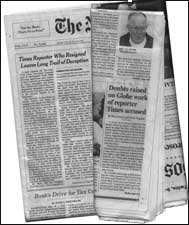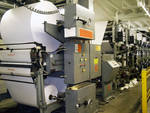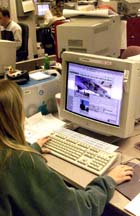| (insert your NIE or newspaper logo here) |
Weekly Online LessonOnline Lesson ArchiveGrade Level: 8-12
|
Newspapers Facing Change
 On
Friday, November 11, 2005, award-winning newspaper San Jose Mercury
News, owned by media giant Knight-Ridder, printed the
last of its foreign language papers.
On
Friday, November 11, 2005, award-winning newspaper San Jose Mercury
News, owned by media giant Knight-Ridder, printed the
last of its foreign language papers.
While the Spanish Nuevo Mundo, fourth in popularity among other Spanish newspapers, will unlikely be revived, the Vietnamese-language Viet Mercury was sold to new owners.
The Mercury News also recently cut staff numbers, including 52 reporters, editors, photographers and newsroom support staff—roughly 17 percent of its crew.
The Mercury News isn't alone. The Philadelphia Daily News, the Boston Herald, The New York Times, the San Francisco Chronicle, The Baltimore Sun, and others have also pressed for staff buyouts and retirements to drop staff numbers over the last year or so.
This uncomfortable trend in newspaper publishing is typically attributed to rising newsprint and health costs, coupled with falling advertising revenues.
Some believe that printed newspapers will ultimately disappear completely, as the rise of digital news continues to grow.
Regardless of how news gets to us, we rely on journalists to provide news coverage that is clear, accurate, and thorough.
For this week's lesson you'll learn how newspapers are produced. You'll also get some training in what it takes to be a news journalist so that you can investigate, write, and share your own stories.
How Newspapers Work
 More and more
of today's readers are using the Internet as a news source. Even so,
many readers still prefer to hold and read a printed newspaper as
opposed to reading news on a computer screen.
More and more
of today's readers are using the Internet as a news source. Even so,
many readers still prefer to hold and read a printed newspaper as
opposed to reading news on a computer screen.
Newspapers have been part of human culture for centuries; they were the first means of mass communication. Is there still a place for newspapers in the digital age? Consider this question as you read How Newspapers Work at the How Stuff Works site.
What factors influenced the changing role of American newspapers over time?
In the 20th century, newspapers began competing with a new form of media: Television. So, What Did the Growth of TV News Mean to Newspapers?
What are the five "streams" most important to news readers? How do the effects of television news on newspapers compare with the effects of Web-based news?
Next, discover What News Is.
What exactly does a reporter do? What is a "beat"? In what ways do reporters serve the general public? What are the responsibilities of the different types of editors?
 Why
do newspapers often consider themselves the "fourth branch" of government?
How does this role contribute to the identity and functioning of our
nation?
Why
do newspapers often consider themselves the "fourth branch" of government?
How does this role contribute to the identity and functioning of our
nation?
Of course, most newspapers publish more than "just the facts;" they also include Editorials.
What is the difference between a news story and an editorial? Why are in-house editorials, letters to the editor, and advertisements vital elements in a newspaper's content?
Okay, so you get how and why people write news stories and editorials, but exactly How Is a Newspaper Produced once you've got the content to roll with?
Why do publishers prefer "cold type" over "hot type" presses? Why has offset printing become the primary method used? About how many copies an hour can they produce?
After production, newspapers must then be Distributed to its subscribers and retail outlets.
Why does a large metropolitan region often produce more than one edition? How many different steps does a newspaper go through from reporter to reader? How does that compare to publishing similar content in a Web edition?
Reporter's Notebook
 As
you've learned, a newspaper—in print or online—relies heavily
on the skills and experience of its reporters and editors.
As
you've learned, a newspaper—in print or online—relies heavily
on the skills and experience of its reporters and editors.
To discover what it takes to be a reporter, open up Poynter's High School Journalism Guide.
Read about how "Getting It Right" is the foundation of good news journalism. Then, get an overview of how to Work Like a Pro and How to Gain Confidence.
In what ways can criticism help a reporter improve skills and stories? What's the importance of dumb and difficult questions? How can first-hand observations and details contribute to a good story? Why should reporters try to write stories from a less conventional perspective?
For those who might prefer the editorial side of journalism, learn more about Writing the Editorial and hear from Dave Berry on Being Funny.
Once written, an article must go through Effective Editing and using The Best Spell-Checker. Try using these tools to go through an essay or other writing assignment you've done recently. Can you find ways to improve what you wrote?
Before leaving Poynter, review the Ethics Checklist and find out why Diversifying Your Coverage is critical to a solid story that will interest readers.
Now, take another step into High School Journalism and Test Your Skills in good writing and journalism-related trivia.
Next, spend a half-hour at the SPLC to Test Your Knowledge in Student Press Law.
 If
you were a reporter at your own school, what kinds of topics and issues
would you choose to cover and why? What sources would you use? Who,
if anyone, would want try to censor one or more of those stories and
why? What laws could protect you if you published the article? What
steps would you take to ensure the accuracy of the story and your credibility
as a journalist?
If
you were a reporter at your own school, what kinds of topics and issues
would you choose to cover and why? What sources would you use? Who,
if anyone, would want try to censor one or more of those stories and
why? What laws could protect you if you published the article? What
steps would you take to ensure the accuracy of the story and your credibility
as a journalist?
If you'd like to learn more about how to become a good journalist, get started at Virginia Commonwealth University with Beginning Reporting. Here, you'll learn what you need in the Prewriting, Writing, and Rewriting stages.
In your class, or with a group of friends, have each person pick a school news topic to cover. Do the reporting, then serve as each other's editors for constructive feedback on how you can improve your story. What "facts" seem questionable? Is your reporting fair and balanced? Is your writing style clear or confusing?
Newspaper Activities
Browse through issues of The Salt Lake Tribune and pull out articles written by staff reporters. Sort articles by reporter names. Do the reporters seem to cover certain types of topics, or beats, on a regular basis? Read through the stories, identifying information presented as facts in the story. What are some tools the reporter may have used to confirm the accuracy of each piece of information? Also, highlight the names of sources the reporter used. How credible is each source and why? Next, pick out some of the details used in each article that helped make the story more interesting. For example, did he or she describe a scene or person's character in some way? As you read the articles written by different reporters, can you identify a particular writing style each of them has? Lastly, contrast news stories with editorials and humor columns. In what ways are they similar? How are they different?
© Copyright 2005
Learners Online, Inc.
